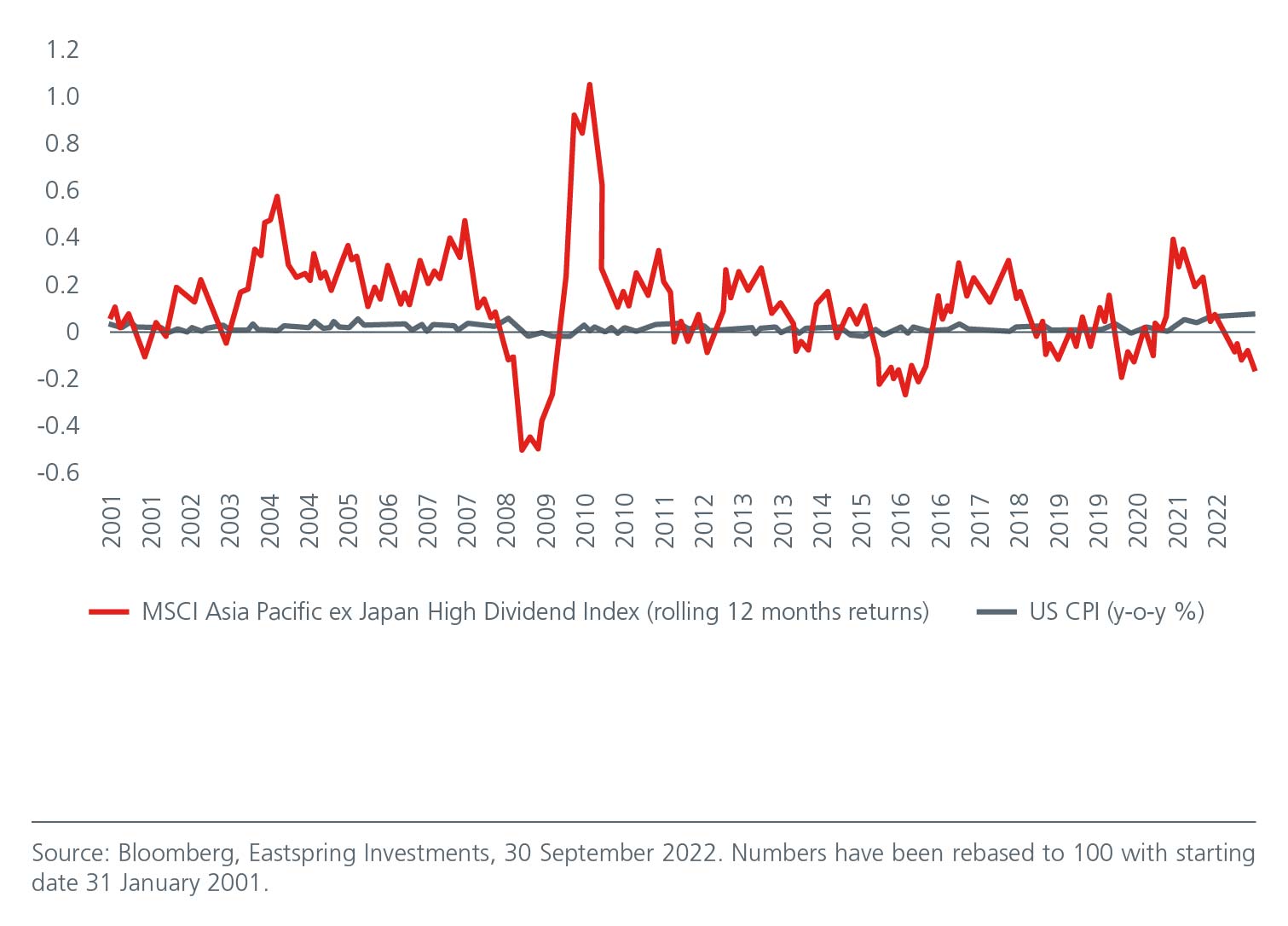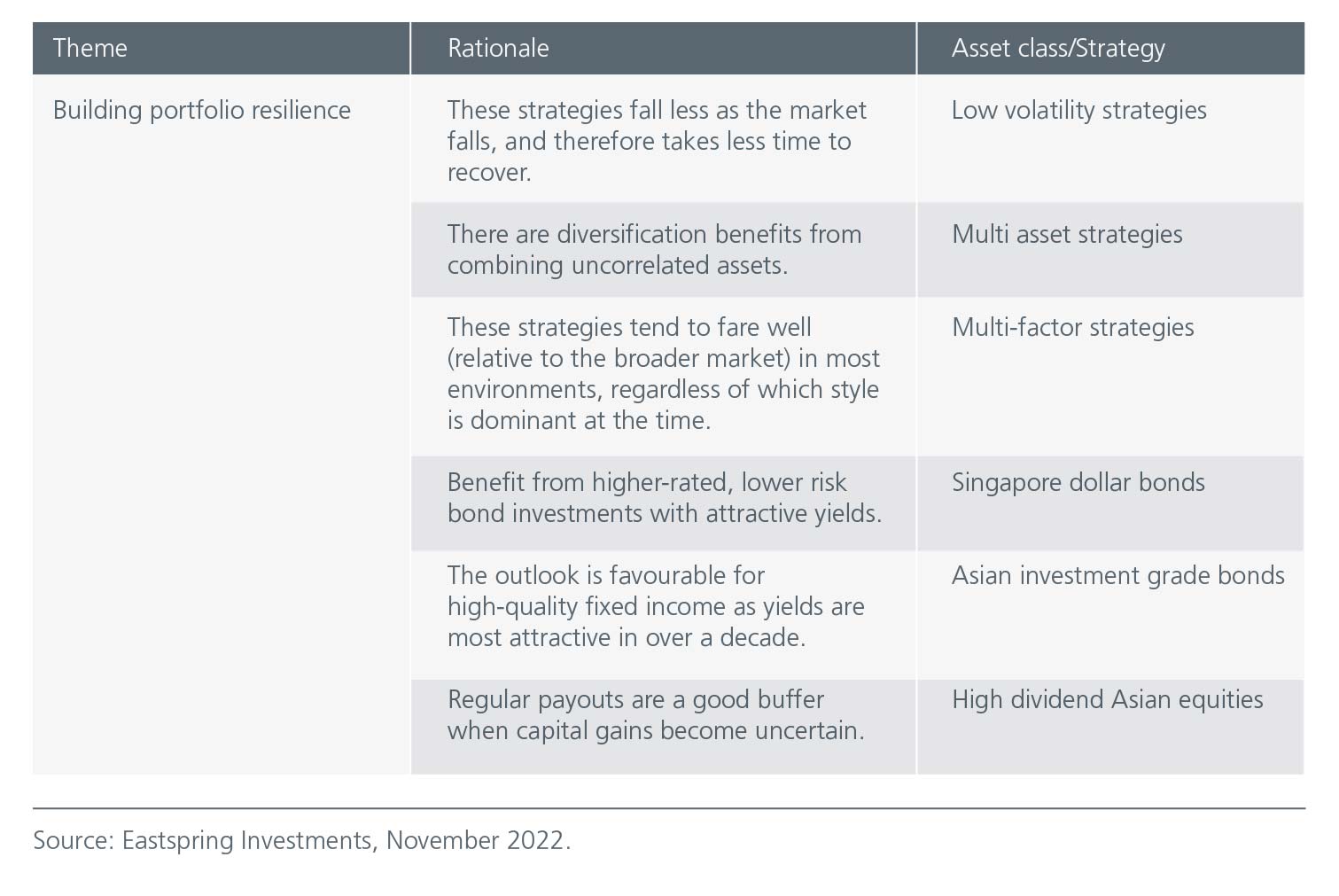Summary
Portfolio resilience is going to be very important over the next 12-18 months as we transit from an inflation dominant regime to a more uncertain environment. Can the US Fed engineer a soft landing or is a recession upon us? Regardless, we expect volatility to remain very elevated. The best way to cope with this type of uncertainty is to build a lot more diversification into portfolios.
Predicting precisely which events or themes will drive volatility in 2023 might be challenging. Although markets seem to have priced in balanced views on whether inflation will revert to more tolerable levels quickly or remain at high levels, we expect future market reactions to be strongly news flow driven. The path ahead is thus likely to be choppy but there are options to reduce the overall levels of volatility in investors’ portfolios.
Building durability with multi assets
Our multi asset team uses a few strategies to optimise risk-adjusted returns in their portfolios over the short-term and long-term horizons and across all market cycles: namely diversification, tactical overlays and risk prudent derivative strategies.
Asset class diversification from a traditional perspective consists of combining assets with different correlation profiles. However, as we have seen this year, strong inflation dynamics (and strong initial valuations) have made the equity-bond correlations less negative and less reliable than before. In the current new environment in which inflation (and interest rates) are likely to stay higher for longer, we believe that less traditional diversification methods, such as investment style factor diversification in equities, become increasingly important and valuable.
That said, the team continues to have faith that the historical relationship between equities and bonds will reassert themselves in time. After all, it is when both equities and bonds are reasonably valued that they provide the most diversification benefits.
Tactical overlays are another option. These are typically designed to either limit a certain risk or to take advantage of market sentiment. In the current market environment, investors need to have exposures to defensive assets that can help pre-empt violent reactions in the markets.
Lastly the team believes that risk managed derivative strategies can be beneficial to portfolios. In multi asset portfolios where guidelines permit the use of derivatives, the team has taken advantage of volatility curves to add portfolio hedges. For example, amid this year’s downtrend in US equities, the team put on a long calendar put spread strategy in certain portfolios to hedge against a downside scenario in US equities.
Going defensive with quant strategies
Smart beta and multi-factor equity strategies have performed well this year relative to broad parent equity indices. Low volatility strategies tend to fare well relative to the broader market during periods of uncertainty and market volatility. By owning stocks and ultimately building a portfolio that is less influenced by the swings in market sentiment, low volatility strategies are by nature more defensive. They also tend to give up less performance as the market falls, and as a result do not need to participate as much in the upside to stay ahead.
A well-diversified approach to low volatility is key though as it will be important to ensure wide representation from all sectors of the market to avoid missing some of the key themes that may take hold in 2023.
A multi-factor strategy is designed to have a similar level of volatility to the broader market and hence less defensive than low volatility. However, by design, this strategy is well diversified across various factors (or styles) and better risk controlled relative to the market benchmark. As a result, it tends to fare well (relative to the broader market) in most environments, regardless of which style is dominant at the time. This should be a useful characteristic to investors in an uncertain environment like we expect in 2023.
Buffering via an income approach
As per our narrative in “Mapping another new normal”, we expect inflation and interest rates to remain higher for longer. In such conditions, investors will be on the lookout for inflation hedges and higher yields.
Listed real estate is normally seen as good inflation hedge. In general, the overall return and dividend growth have been consistently ahead of inflation over the long term. In some markets such as Australia, UK, and Europe, rentals are linked to an inflationary measure which will provide some earnings buffer for the asset owner.
Likewise, selecting stocks that have stable dividend payouts will ensure a steady stream of regular income which can result in positive real yields. In Asia Pacific ex Japan, the high dividend total return index usually delivers superior returns to US inflation across most periods.
Asian high dividend yielding equities also have a low correlation to Asian bonds at 0.30 and 0.47 against Asian investment grade and non-investment grade bonds respectively.1 This is a plus for investors seeking to build a diversified portfolio of income producing assets.
Asian high dividend yield index returns mostly exceed US inflation

Short-term government securities are another income option for investors. This is especially so if the country enjoys a solid AAA rating; Singapore government securities have hit multi-decade highs this year with yields above 4% compared to the 1% at the start of the year. Investors no longer have to actively seek risk to obtain meaningful returns on their savings. We are likely to see money continuously flock towards short-term government securities with interest rates remaining high.
Furthermore, investors can lock in positive real returns by allocating capital to short-term investment grade securities backed by healthy issuers that are yielding above inflation. The outlook for high-quality fixed income has turned more favourable and their absolute yields are at their most attractive levels in over a decade.
Investment implications

Contributors:
Craig Bell, Head of Multi Asset Portfolio Solutions, Eastspring Singapore
Ben Dunn, Head of Quantitative Strategies, Eastspring Investments
Danny Tan, Head of Fixed Income, Eastspring Singapore
Katerina Irwan, Portfolio Manager, Equities, Eastspring Singapore
Bonnie Chan, Portfolio Manager, Equities, Eastspring Singapore
Key themes
Sources:
1 Bloomberg. Weekly data from November 2012 to November 2022. Indexes used: MSCI Asia Pacific ex Japan High Dividend Yielding Net Return Index, JACI Investment Grade Total Return Index, JACI Non-Investment Grade Total Return Index. In USD terms.
Singapore by Eastspring Investments (Singapore) Limited (UEN: 199407631H)
Australia (for wholesale clients only) by Eastspring Investments (Singapore) Limited (UEN: 199407631H), which is incorporated in Singapore, is exempt from the requirement to hold an Australian financial services licence and is licensed and regulated by the Monetary Authority of Singapore under Singapore laws which differ from Australian laws
Hong Kong by Eastspring Investments (Hong Kong) Limited and has not been reviewed by the Securities and Futures Commission of Hong Kong.
Indonesia by PT Eastspring Investments Indonesia, an investment manager that is licensed, registered and supervised by the Indonesia Financial Services Authority (OJK).
Malaysia by Eastspring Investments Berhad (200001028634/ 531241-U) and Eastspring Al-Wara’ Investments Berhad (200901017585 / 860682-K) and has not been reviewed by Securities Commission of Malaysia.
Thailand by Eastspring Asset Management (Thailand) Co., Ltd.
United States of America (for institutional clients only) by Eastspring Investments (Singapore) Limited (UEN: 199407631H), which is incorporated in Singapore and is registered with the U.S Securities and Exchange Commission as a registered investment adviser.
European Economic Area (for professional clients only) and Switzerland (for qualified investors only) by Eastspring Investments (Luxembourg) S.A., 26, Boulevard Royal, 2449 Luxembourg, Grand-Duchy of Luxembourg, registered with the Registre de Commerce et des Sociétés (Luxembourg), Register No B 173737.
Chile (for institutional clients only) by Eastspring Investments (Singapore) Limited (UEN: 199407631H), which is incorporated in Singapore and is licensed and regulated by the Monetary Authority of Singapore under Singapore laws which differ from Chilean laws.
The afore-mentioned entities are hereinafter collectively referred to as Eastspring Investments.
The views and opinions contained herein are those of the author, and may not necessarily represent views expressed or reflected in other Eastspring Investments’ communications. This document is solely for information purposes and does not have any regard to the specific investment objective, financial situation and/or particular needs of any specific persons who may receive this document. This document is not intended as an offer, a solicitation of offer or a recommendation, to deal in shares of securities or any financial instruments. It may not be published, circulated, reproduced or distributed without the prior written consent of Eastspring Investments. Reliance upon information in this document is at the sole discretion of the reader. Please carefully study the related information and/or consult your own professional adviser before investing.
Investment involves risks. Past performance of and the predictions, projections, or forecasts on the economy, securities markets or the economic trends of the markets are not necessarily indicative of the future or likely performance of Eastspring Investments or any of the funds managed by Eastspring Investments.
Information herein is believed to be reliable at time of publication. Data from third party sources may have been used in the preparation of this material and Eastspring Investments has not independently verified, validated or audited such data. Where lawfully permitted, Eastspring Investments does not warrant its completeness or accuracy and is not responsible for error of facts or opinion nor shall be liable for damages arising out of any person’s reliance upon this information. Any opinion or estimate contained in this document may subject to change without notice.
Eastspring Investments companies (excluding joint venture companies) are ultimately wholly owned/indirect subsidiaries of Prudential plc of the United Kingdom. Eastspring Investments companies (including joint venture companies) and Prudential plc are not affiliated in any manner with Prudential Financial, Inc., a company whose principal place of business is in the United States of America or with the Prudential Assurance Company Limited, a subsidiary of M&G plc (a company incorporated in the United Kingdom).






